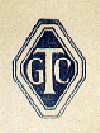 |
The Girls'
Training Corps
No 816
(Bourne) Company |
Among the lesser known of the pre-service units that operated in Britain during the last century was an organisation dedicated to the wider aims of citizenship for young ladies with instruction in home making, craftsmanship and public affairs. The National Association of Girls' Training Corps was set up by the Board of Education (forerunner of the Ministry of Education) during the early years of the Second World War (1939-45) with units in most cities and towns and No 816 (Bourne) Company was formed on 7th March 1943.
The company was organised on military lines with Dr Ruth C Finn as Commandant with other officers acting as adjutant and quartermaster. The uniforms consisted of black shoes, navy skirts, white blouses, navy ties and navy forage caps, and there were ranks and promotions for leadership and good conduct.
|
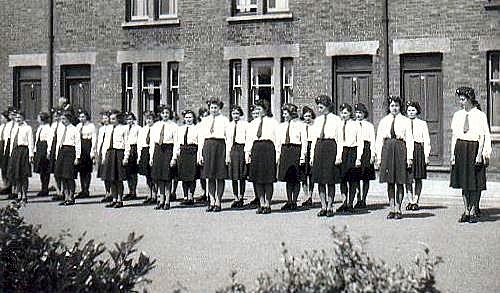
|
|
Girls
on parade in Harrington Street which became their usual meeting
meeting point on drill nights (above) and a group photograph
(below), both pictures taken circa 1943.
|
|
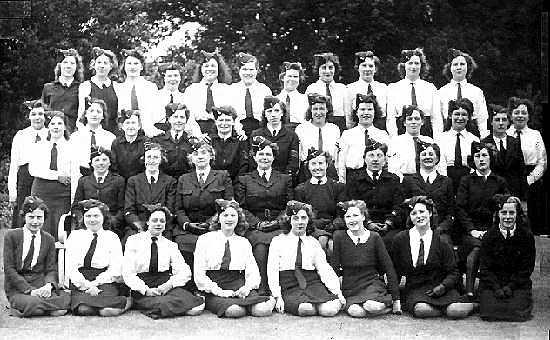 |
There was also a lot of drill and many parades although there was a particularly strong community element in its objectives.
In a message to her new recruits, Dr Finn, daughter of local general practitioner Dr John
Galletly (senior), said: "It is hoped to train each cadet for service to the community, both as a woman and a citizen, and show her opportunities for immediate service, the motive
of which shall be to provide out of her own leisure, leisure for others. Will you all remember this as you get older? Help young people wherever you find them. Our GTC will then be fruitful indeed."
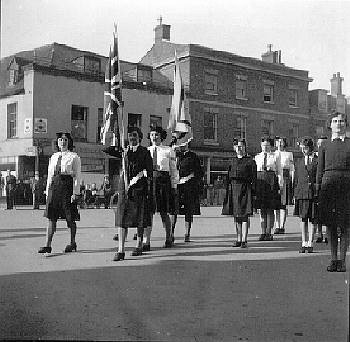 |
The Girls' Training
Corps took part in all of the ceremonial parades through Bourne
during the Second World War, together with other uniformed
organisations such as the Home Guard, the Red Cross, WVS, the Army
and Air Force cadets and the St John's Ambulance Brigade, and they
are pictured here in the market place parading their colours on
Sunday 10th September 1944. |
Typical training sessions were lectures on home nursing given by officials from the Red Cross, practical work on bed making at the mental hospital in St Peter's Road, drilling, talks on leadership, organisation and etiquette, ambulance work and stretcher bearing, sanitation, local government, map reading and the Morse code. The girls also had an active social life and the company celebrated its
second birthday with a social and dance at the Corn Exchange in March 1944 when members of the Army Cadet and Air Training Corps were
invited. There were also garden fetes, summer games evenings at the Abbey Lawn, and other events but all usually had a fund raising element for good causes, often the war effort.
These activities included knitting for the WVS and for refugees in occupied Europe, picking rose hips for turning into syrup, farm work and by raising money to help the forces.
Highpoint of the winter was an annual pantomime and most of the girls gave up their free evenings to rehearsing for the show, one of the most successful being a production of Cinderella that was presented at the Corn Exchange on 10th and 11th January 1945.
|
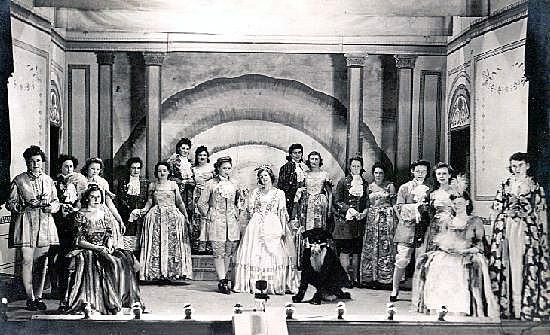
|
|
The Christmas
pantomime production of Cinderella that was staged at the Corn
Exchange early in January 1945. The show was produced by Mrs
Harold Pick and featured Nancy Cooper (Cinderella), Eva Courton
(Whiskers the Cat), Millie Buswell (Buttons), Josie Sneath and
Betty Astley (the Ugly Sisters), Ethel Palmer (Lady Gorgonzola),
Marian Davis (herald), Phyllis Stephenson (Fairy Godmother) and
Joan Winters (Prince). Others taking part were I Fisher, A Horsman,
E Fowler, J Lyon, P Bloodworth and E Smith (chorus boys); G
Tupholme, M Needham, A Rodgers, D Reynolds, A Ashton and R Genever (chorus girls); M Griffin, J Cooper, J Machin, K Jackson,
M Kettle and D Smith (fairies). |
|
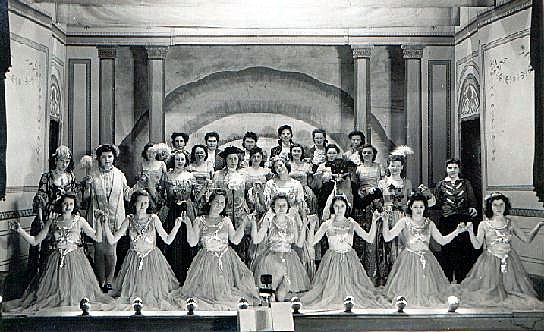 |
Ceremonial occasions were also popular and the company turned out in strength on 22nd May 1944 to mark Youth Sunday, marching behind the army cadet band from Harrington Street for a service at the Baptist Church in West Street, each local church and chapel being chosen in annual rotation. A second parade was held that year on June 4th for Salute the Soldier Week, a national patriotic celebration of the army's role in the Second World War that was then in progress and several of the girls went on to regular military service with the ATS and the WRENS.
There were other regular parades for the presentation of long service
stripes and proficiency badges.
Training courses were also held outside the town, at Stamford, Lincoln and other venues, where the girls, many of them away from home for the first time, were treated to a taste of communal living, sleeping on palliasses on the floors of drill halls, doing their ablutions in washrooms and eating cookhouse meals prepared by the local WVS.
The Bourne company was presented with its own flag on Sunday 10th September 1944 by Miss Curlett, Director of the Girls' Training Corps, showing the blue, wine and black colours of the movement, and the handing over ceremony was followed by a parade to the Abbey Church where the flag was dedicated and blessed. Later that day, cadets from Bourne went by coach to a rally at Grantham where they were addressed by
the director of the GTC, Miss Kathleen Curlett OBE, and afterwards there
was a discussion on the future of the corps. All agreed that it should continue after the war but with modifications in the uniform and the basic training but this optimism failed to materialise.
Dr Finn resigned in April 1945 when she returned to her home in London to
work and she was succeeded as commandant by Joan M Crofts who remained in
office until the Bourne company disbanded soon after the war ended in
1945.
|
ALL THE NICE GIRLS LOVE A SAILOR
The Bourne company decided to help the war effort in December 1943 by adopting one of the ships in the Royal Navy. The scheme was given the blessing of the Admiralty and the craft chosen was the minesweeper HMS Walwyns Castle.
Girls were soon sending off parcels for the crew, including a gramophone and a collection of records, when the ship was based at the Isle of Lewis. Books, stationery and other comforts followed on a regular basis, paid for with money raised from whist drives and dances. Crew members responded with letters of thanks and accounts of their doings, giving themselves
names such as Sparks (telegraphist), Bunts (signalman) and Stoker (responsible for the boilers). One of them who signed himself Guns (a gunner) was so good looking that he became the company's pin-up boy and the photograph he sent was put on display on parade nights together with a beautifully-crafted model of the ship that he had made that was also the centrepiece at a garden fete held in the grounds of Dr Galletly's home in North Road during the following summer.
The 225-ton HMS Walwyns Castle was a small craft with a crew whose ages ranged from 20 to 50 and their homes were in all parts of the British Isles and had a variety of occupations before joining the service, from deep sea fishermen to office workers. In November 1944, the girls decided on a special present to celebrate Christmas and despite wartime food rationing, they banded together to provide the ingredients for a massive cake that was despatched in time for the festive season.
The ship survived the war. HMS Walwyns Castle was a former fishing trawler, built in 1916 and requisitioned by the Admiralty in February 1940 when it was converted for use as a minesweeper. When the war ended, it was returned to the owners in March 1946 and resumed its original role. |
|
A FORMER CADET REMEMBERS .
. . .
Among those who joined the GTC was Ruth Genever, a 16-year-old shop assistant from 16 George Street, Bourne, who enlisted on 29th March 1943.
She is now Mrs Ruth Peat, aged 75, of Bedehouse Bank, Bourne, and remembers those days with fondness. "It was an exciting experience
and I know that I benefited from it later in life", she said. "We trained in a variety of courses from first aid and map reading to cookery and home nursing. We were taught hygiene and to take care of our feet and teeth as well as mothercraft and other military duties such as fire fighting, aircraft recognition and carrying and memorising messages in case we were needed in the event of an invasion. It may seem strange to the younger generation today but in wartime is was all deadly serious."
She was also given drama tuition and was one of the chorus girls in the pantomime Cinderella staged by the corps in January 1944 and pictured above.
Ruth remained in the corps for 2½ years and was one of the many girls who went on to a full time career in the services, enlisting in the ATS on 10th September 1945. |
Note:
Dr Ruth Finn died in 1992 and is buried alongside her husband Richard
in
the Galletly family grave in Bourne cemetery.
REVISED MARCH 2014

Go to:
Main Index Villages
Index
|




